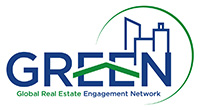Q&A webinar: GREEN’s Findings & Investor Expectations for Listed Real Estate
GREEN recently hosted a webinar attended by 80 REITs and REITs investors. It focused on last year’s findings from engagements with listed real estate companies and provided insights from investor member Wellington Management, about their engagement approach across the real estate space. The Q&A session gave some great insights into engagement and climate risk management by global REITs, which we have summarised in this article.
Did you miss this webinar? Find de recording and the presentation slides online.
1# Which aspects of GREEN’s Investor Statement resonated the most with Wellington’s investment process?
Bradford Stoesser (Global Industry Analyst specializing in real estate companies and REITs, Wellington Management) discussed two aspects.
Firstly, he believes action item 2, implementing a strong governance framework for climate change, is the most relevant from a risk mitigation perspective for global REITs. Given the physical, immovable nature of real assets, companies’ mitigation and resilience strategies are imperative to long-term value creation. Today, some clear evidence of the intersection of climate risk and real estate stock prices is the impact of elevated insurance expenses on margins.
The second action item that is especially significant is developing and managing progress against a science-based transition pathway to meet the Paris agreement accords. Where consistent with their philosophy and process, some of Wellington’s research and investment teams will integrate low-carbon transition goals into the portfolio construction process. Within real estate, it is often financially material as companies with more efficient buildings will enjoy lower operating costs and provide better net operating income.”
#2 The market environment has changed. The cost of capital has increased, and we can’t spend the money that we don’t have. Is it fair to hold companies accountable for Scope 3 emissions?
Vincent van Bijleveld (GREEN) shared that every member of GREEN ultimately has its own approach, but on balance, he believed it fair to hold landlords responsible for Scope 3 emissions. The heating and cooling of a building are responsible for a large share of Scope 3 emissions which are determined by insulation levels and HVAC systems to a large degree, for which landlords in most cases are responsible. Therefore, although a REIT cannot control all tenants’ energy use, most members would say it’s important to look at a “Scope 3 whole-building approach” when assessing risk.
#3 How should we address climate risk management under these circumstances?
Bradford addressed REIT concerns that the current higher cost of capital for companies is affecting their ability to spend money on environmental measures. He agreed companies are finding higher interest rates make it challenging to carry out climate-related investments. Examples of recent tail risk highlight the issue. Companies were not concerned about access to the insurance markets at all two years ago, but premiums are up 20% to 80% which will pressure margins. In some cases, companies are effectively self-insuring which presents future tail risks. Emission-related legislation should also be a consideration e.g. failure to comply with Local Law 97 in New York City, can result in fines of up to 50c per sq. ft. The UK’s EPC regulations from 2030, will prohibit leasing buildings unless they have a B rating or higher.
So companies should balance longer-term issues like legislative and private market tail risk, alongside their current concerns about capital costs. Companies can take several steps in the current market. They can improve asset-level data collection to allow better portfolio positioning for tail risk, and thus better capital allocation. They can find assets that exceed traditional return levels. Finally, they can map out their business plans with finance teams to better understand the risks associated with executing or not adopting climate-related investments.
#4 How does Wellington assess physical climate risks?
Bradford discussed their collaboration with Woodwell Climate Research Centre to bridge the gap between climate science and finance by better understanding the potential impact of climate variables (such as heat, drought, wildfire, flood, and hurricane) on asset prices. This climate data is overlaid with capital market insights that include municipalities’ fiscal ability to manage the impacts of climate events. Wellington’s real estate team uses the model to assess risks to over 500,000 REIT-owned global assets in their investment portfolios and understand companies’ underlying tail risks.
#5 How does Wellington view laggards in terms of climate risk management?
Bradford explained his process which begins with working with management across a range of metrics, including financials, compensation structure, investor alignment, climate risk mitigation, and other ESG factors. His team discusses with management how to improve the company’s overall financials, performance, and governance, including climate risk and remuneration. The 2nd step may be to engage with the board members, both independents and non-independents, which can also involve writing a formal letter and voting via proxy. If the earlier engagement steps are unsuccessful and the company is considered likely to underperform Wellington may consider a reduced or eliminated position.
Questions about the webinar?
Do you have another question? Feel free to contact the GREEN team.
Did you missed out on this webinar, don’t worry! Go this the page to find access to the full webinar recording and the presentation slides online.
What’s next? We are excited to share our upcoming webinar on October 3rd: “Unlocking Climate Insights: Risk Metrics and Collaborative Engagement in Real Estate.” Click here for more information.






